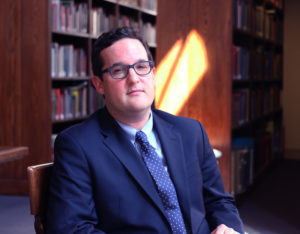The U.S. Climate Resilience Toolkit gains a significant new capacity this week—a dedicated section on the built environment—and the Harvard Graduate School of Design’s Jesse M. Keenan is a central figure in its conception and development.
Launched in November 2014 as part of President Obama’s Climate Action Plan, the U.S. Climate Resilience Toolkit (CRT) at climate.gov provides access to maps, tools, and resources to help communities and businesses build resilience to climate-related impacts and events. Hosted by NOAA, the CRT comprises thematic resource sections, including water, energy, and health.
Keenan serves as editorial team co-lead for the newly added Built Environment section. Alongside two other editorial co-leads, he has directed the section’s development along with NOAA, the U.S. Forest Service, and a team consisting of various agencies and stakeholders, under the auspices of the Community Resilience Panel for Buildings and Infrastructure Systems.
As Keenan notes, expressing a focus on the built environment is essential in diversifying the narrative on climate change.
“We tend to remotely conceptualize climate change in terms of global environmental impact without giving consideration to the incremental impacts in the built environment that resonate with our everyday lives,” he says.

Unveiled this week by the White House, the CRT’s new Built Environment section contains authoritative, peer-reviewed, science-based information, including case studies, data sets, state and local reports and action plans, training courses, and other planning guides. As Keenan highlights, “this section acknowledges the interdependencies between physical, biophysical and social systems in the built environment.” It adds resources focused on stressors impacting or exacerbating economic inequality, environmental degradation, and weakening social support systems, which can make communities more vulnerable to the sort of extreme weather and climate events that are becoming increasingly common. At the same time, the section provides technical resources for everything from adaptive design of civil infrastructure to risk-mitigation techniques in architecture.
The Built Environment section also represents an important step in the advancement of interagency collaboration and dialogue. Keenan worked with the National Security Council at the White House to transpose a taxonomy of resilience that could be communicated across various agencies, programs, and stakeholders. It helped to focus and enhance the definitions of resilience and adaptation in terms of the nation’s cities and towns and facilitate an exchange of information among designers, planners, and various government agencies and entities.
“We consulted with experts in the field, as well as end-user communities, to help us tailor this section of the Toolkit to help urban and suburban planners meet a wide range of climate-related issues threatening our nation’s built environments,” says Dr. Nancy Beller-Simms, program manager in NOAA’s Climate Program Office and one of Keenan’s principal project collaborators.
Questions of climate change and the built environment are increasingly central to the dialogue and work of GSD faculty. In partnership with the City of Miami Beach, the School’s recently launched Office for Urbanization took on sea-level rise as its foundational project, and an associated Spring 2016 studio, “Miami Rise and Sink,” examined this concern in the context of designed adaptations across the scales of architecture, urban design, and landscape. The Harvard Center for Green Buildings and Cities has also provided leadership for advancing new knowledge of various modes of design and analysis that serve a variety of co-benefits, including climate mitigation and resilience. Within the GSD’s Master in Design Studies program, the Risk and Resilience concentration prepares students to identify, articulate, and propose preemptive forms of practice.
Keenan joins the GSD as a member of the faculty of the Department of Architecture. He teaches courses and conducts research in the fields of real estate development, design-development technology, and climate adaptation science. Keenan formerly served as the co-founder and Research Director of the Center for Urban Real Estate (CURE) and as a member of the faculty at Columbia University’s Graduate School of Architecture, Planning and Preservation (GSAPP).
In addition to serving as an editorial co-lead for the Built Environment section, Keenan presently serves as the Vice-Chair for the U.S. Community Resilience Panel for Buildings and Infrastructure Systems, a federal interagency initiative under the White House Climate Adaptation Plan supported by the National Institute of Standards and Technology in partnership with the U.S. Environmental Protection Agency, Department of Homeland Security, Federal Emergency Management Agency, and the Department of Housing and Urban Development.